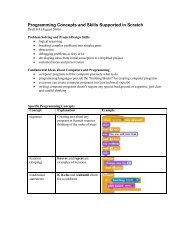Gaming Literacies: A Game Design Study in Action - MIT
Gaming Literacies: A Game Design Study in Action - MIT
Gaming Literacies: A Game Design Study in Action - MIT
You also want an ePaper? Increase the reach of your titles
YUMPU automatically turns print PDFs into web optimized ePapers that Google loves.
<strong>Gam<strong>in</strong>g</strong> <strong>Literacies</strong>: A <strong>Game</strong> <strong>Design</strong> <strong>Study</strong> <strong>in</strong> <strong>Action</strong> 315<br />
knowledge <strong>in</strong> practice, capitaliz<strong>in</strong>g on the k<strong>in</strong>ds of reflection-<strong>in</strong>-action that<br />
will undoubtedly take place. <strong>Game</strong>star Mechanic aims to teach basic game<br />
design fundamentals, as well as model basic practices of a game designer.<br />
Because design<strong>in</strong>g games is a complex, multilayered design activity, the<br />
process of design is scaffolded through game design challenges, with game<br />
modification be<strong>in</strong>g the primary way players are <strong>in</strong>troduced to both the elements<br />
of a game, and game design core pr<strong>in</strong>ciples.<br />
In determ<strong>in</strong><strong>in</strong>g the knowledge base that forms the basis of the experience,<br />
we considered not only the core design pr<strong>in</strong>ciples to be taught, but also<br />
the range of activities players would need to experience if we were correctly<br />
model<strong>in</strong>g the practice of a game designer. In addition, we thought about the<br />
k<strong>in</strong>ds of game design roles a player would need to take on dur<strong>in</strong>g the experience,<br />
<strong>in</strong> order to fully embody the multiple roles a game designer assumes <strong>in</strong><br />
their field. Taken together, this list of fundamental pr<strong>in</strong>ciples, best practices,<br />
and roles provide a bluepr<strong>in</strong>t for the <strong>Game</strong>star Mechanic experience, giv<strong>in</strong>g<br />
specific guidance to the test<strong>in</strong>g and assessment components. S<strong>in</strong>ce we<br />
know the nature of the specific practices and concepts that def<strong>in</strong>e the k<strong>in</strong>d of<br />
th<strong>in</strong>k<strong>in</strong>g we want to reproduce, we can work to embody these as best we can<br />
with<strong>in</strong> the structure of the game itself. We can also test directly for evidence<br />
that players are tak<strong>in</strong>g on these roles: are they learn<strong>in</strong>g to speak, act, and<br />
th<strong>in</strong>k like game designers Reproduction of these pr<strong>in</strong>ciples by players will<br />
help us to measure to what degree our design is work<strong>in</strong>g to teach.<br />
Core game design pr<strong>in</strong>ciples to be taught. <strong>Game</strong> design is a complex,<br />
multilayered design activity, whereby systems of mean<strong>in</strong>g (games) are created<br />
through the design of rule sets result<strong>in</strong>g <strong>in</strong> play. As products of human<br />
culture, games fulfill a range of needs, desires, pleasures, and uses. As products<br />
of design culture, games reflect a host of technological, social, material,<br />
formal, and economic concerns. Because rules, when enacted by players,<br />
are embodied as the experience of play, game design can be considered a<br />
second-order design problem. A game designer only <strong>in</strong>directly designs the<br />
player’s experience by directly design<strong>in</strong>g the rules of play.<br />
The real doma<strong>in</strong> of game design is the aesthetics of <strong>in</strong>teractive systems.<br />
As dynamic systems, games produce contexts for <strong>in</strong>teraction with strategic<br />
and quantifiable outcomes. This <strong>in</strong>teraction is often digitally mediated (videogames<br />
are played on computers, consoles, or other digital platforms) but<br />
not always, as much of the knowledge basic to the practice of game design<br />
applies to the design of non-digital games as well. Long before computers<br />
existed, design<strong>in</strong>g games meant creat<strong>in</strong>g dynamic systems for players to <strong>in</strong>habit.<br />
All games, from Chess or Go to The Sims and beyond, are spaces of<br />
possibility for players to explore. <strong>Design</strong><strong>in</strong>g this space is the focus of game







